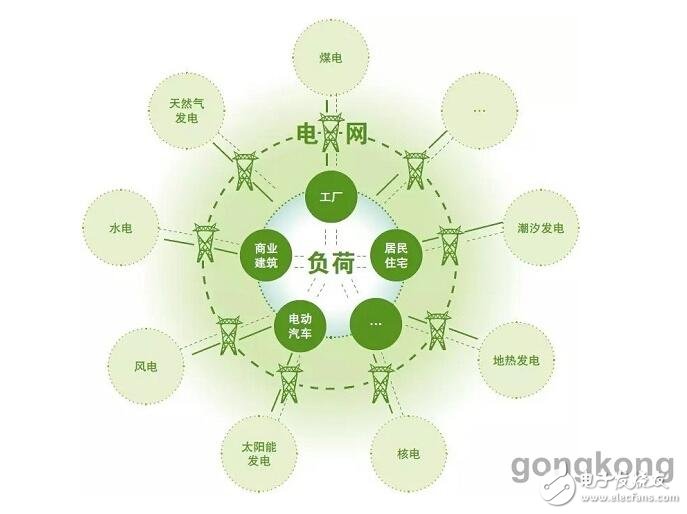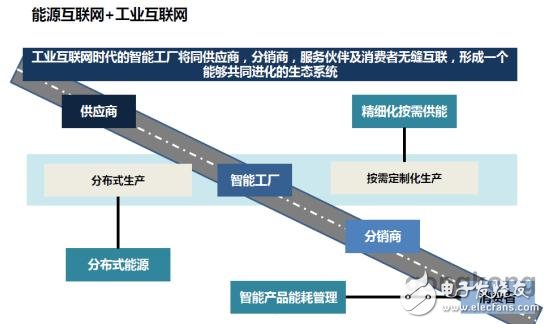If one day, people can use their fingers on their mobile phones to sell excess photovoltaic power on their roofs to their strangers who are ready to charge electric vehicles through WeChat;
If one day, every device, every automated assembly line, energy consumption, operating conditions and carbon emissions, sulphide emissions, nitrogen oxides emissions, etc. of each plant are converted into digital coordinates, managers only need to control the system. , to optimize production settings;
If one day, every second of every need can be accumulated and directed to the most efficient production supply;
The realization of the above various ideas will be entrusted to the huge energy Internet system. This is nothing more than predicted by others, the next king will appear in the field of energy Internet.
Focusing on China, with the clarification of a series of policy orientations such as the "Energy Internet Action Plan Outline", the formation of trillions of incremental markets, and the establishment of many energy companies for the energy Internet, China's energy Internet is experiencing A gradient from 0 to 1.
Policy warm wind, internet + energy effect
Since the government's work report in March this year first proposed to develop an "Internet +" action plan, the Internet + effect has been oscillating. On June 24, Premier Kr. Qiang at the State Council executive meeting confirmed that the "Internet +" Action Guidance Opinions will promote the development of target tasks in 11 key areas such as entrepreneurial innovation and smart energy. At the same time, the National Energy Administration has officially finalized the Energy Internet Action Plan Outline (the Action Plan) and 12 supporting topics.
The energy industry is undergoing tremendous changes under the “Internet Plus†trend. The major central enterprises have “touched the net†and laid out in the fields of “Internet + oil and gasâ€, “Internet + power gridâ€, “Internet + coal†and “Internet + powerâ€. Zeng Ming, the leader of the expert group involved in the formulation of the Action Plan, and the author of the National Energy Internet Action have interpreted the authority.

With the rapid development of renewable energy technology, communication technology and automatic control technology, a power system as the core, centralized and distributed renewable energy as the main energy unit, relying on real-time high-speed two-way information and data interaction technology, covering coal The new energy utilization system of multi-type polymorphic network systems such as oil, natural gas, and road and rail transportation, namely the basic concept and prototype of the “energy internet†was proposed.
The energy Internet is to build a high-integration of power systems as the core and ties, multi-type energy networks and transportation networks, with “horizontal multi-energy complementarity, vertical source-network-load-storage coordination†and energy flow and information flow. The large energy interconnection circle with two-way flow characteristics is to realize the coordinated interaction of “source-network-load-storage†in a broader sense.
Among them, “source†refers to secondary energy sources such as primary energy and electricity such as coal, hydropower and natural gas. The “net†covers natural gas and oil pipeline networks, power networks, and transportation networks such as railways and highways. “Storage†refers to various energy needs and storage facilities. Through the coordination of “source-network-load-storageâ€, the goal of maximizing consumption of renewable energy, coordinated optimization of energy demand and production supply, and optimal allocation of resources is achieved to achieve “clean alternative†and “electrical energy replacement†for the entire energy network. "Promoting the transformation and development of the entire energy industry as well as the economy and society."
The roadmap for the top-level design of the energy Internet is divided into six steps: Internet sales, renewable energy market transactions, carbon market transactions, energy storage, electric vehicles and smart homes. The first goal can be achieved in the last one or two years.
Opportunity to share, smart energy fosters huge business opportunities
It can be seen that the Action Plan spliced ​​a large network of interests involving the entire chain of the energy industry.
Looking at the world, as the world's first country to practice energy Internet, Germany's "E-Energy" technology innovation program successfully established an Internet-based regional energy market, such as intelligent power trading platform to achieve distributed energy transactions in the coverage area. At the same time, more than 1,100 sales companies in Germany have developed various entrepreneurial companies around the fields of photovoltaics, energy storage and electric vehicles.
American electrical giant GE will use the Internet of Things, such as power generation, transmission, distribution, use, and electricity, to match the power generation transaction, and carry out value-added services such as maintenance and energy conservation. Its energy management revenue has reached 44 billion yuan. Google acquired Nest in the field of smart home energy management.
In contrast, China, industry insiders said that China's retail industry + Internet, which accounts for 5% of GDP, has been bred for ten years, which has spawned a market of nearly one trillion yuan. Alibaba, Jingdong and other industry giants have emerged. The combination of the energy industry and the Internet with a GDP ratio of more than 20% will inevitably produce a larger energy body. In the next 10 years, the scale of direct and incidental industries will exceed 20 trillion yuan.
Cross-border integration, with the Internet of Things as the entry point
In the context of “energy interconnectionâ€, the energy supply model and business logic formed in the past 100 years to meet the demand will be completely subverted and transformed into a new philosophical system that integrates demand to optimize production and save resources. In the new system, the various participants in the energy Internet are both “producers†and “consumersâ€.
In the new energy system with energy Internet as the core, smart grid is the energy hub, intelligent buildings are distributed energy + distributed energy storage, smart electric vehicles are low-carbon transportation + distributed energy storage, and smart electricity is smart home. The micro gas turbine is the peaking power.
In addition, the energy Internet needs to be integrated with other systems such as the industrial Internet, the transportation Internet, and the building Internet. Cross-border has become the trend of the times, which requires more patience and innovation courage. Although the top-level design of China's energy Internet was unveiled, the companies that participated in the market have already tried their best to meet the actual needs.

"Internet + oil and gas." For the first time this year, Schneider Electric exhibited a comprehensive solution for a certain industry (petroleum petrochemical and chemical industry). According to the top Chinese Schneider Electric China, they put the expansion of the energy Internet into a branch of the Internet of Things system. Process automation products and solutions such as Foxboro Evo Process Automation System, Triconex Security System, SimSci-Esscor Solution, Process Instrumentation and Wonderware Software, as well as cloud platforms, IT data centers, energy management systems, energy monitoring systems, power distribution equipment, etc. It can help users in the petroleum, petrochemical and chemical industries to achieve a common improvement in safety efficiency, process efficiency, energy efficiency and machine efficiency.
"Internet + grid". In building the future smart grid, Siemens researchers' long-term goal is to combine multiple different types of energy resources, such as oil, natural gas, wind power, solar energy, biomass and waste heat, to ensure that these energy resources are as efficient as possible. An environmentally friendly way to produce electricity, heating, cooling and drinking water. In balancing the supply and demand of electric energy, SOEASY, a self-organizing power automation system provided by Siemens, can realize the electric energy transaction between various power supply facilities and electrical equipment within the coverage.
"Energy Internet + Industrial Internet". Since 2015, ABB has officially joined the Industrial Internet Alliance (IIC), which aims to promote the positive role of the Industrial Internet in the transformation of manufacturing, energy and resource industries. In ABB's view, the key to China's entry into the next stage of growth is to decouple economic growth from environmental pollution. This is also one of the original intentions of energy Internet construction.

"Energy Internet + Building Internet". Advantech's energy management solutions include WebAccess open integration platform, WebAccess+BEMS energy management system, Director command linkage platform and other applications. The “Energy Check†is tailored for the building, which not only makes the building energy consumption visible, data, but also analyzes , simulation, forecasting, assisting owners to specify more accurate energy-saving solutions. At present, office buildings, supermarket chains, universities, hospitals, and hotels that use Advantech's energy management solutions have saved considerable electricity costs.
For the frequent action of enterprises, energy Internet experts said that most of the current companies are doing energy Internet from their own perspective. The real energy Internet is not a company's original business, but an inclusive cross-border. The giants of the future energy Internet may form an inclusive and diversified business model across multiple fields of energy, law, finance, transportation and communication.
Piezo Beeper,Mechanical Buzzer,Piezo Mechanical Buzzer,Ultrasonic Mechanical Buzzer
NINGBO SANCO ELECTRONICS CO., LTD. , https://www.sancobuzzer.com